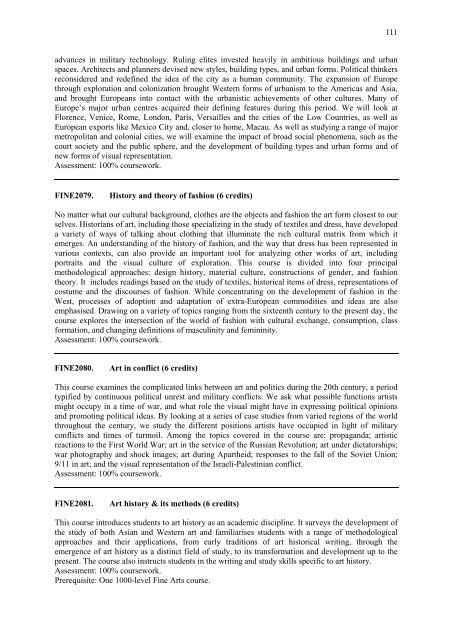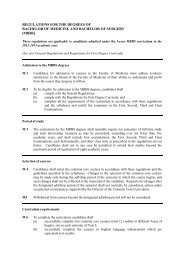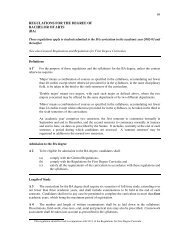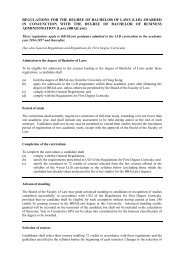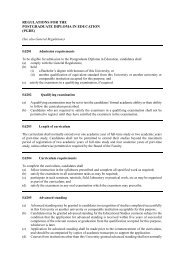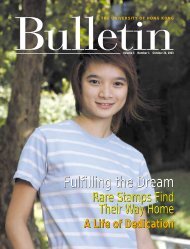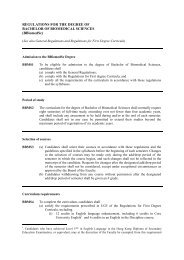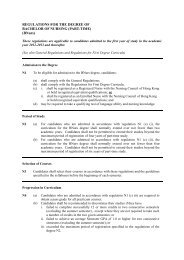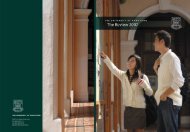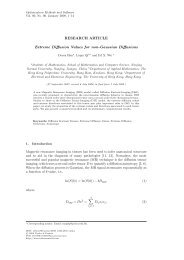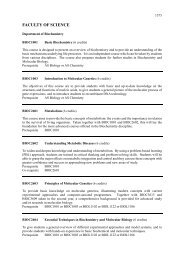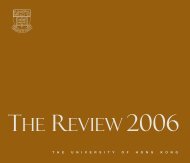(BA) (4-year-programme) - The University of Hong Kong
(BA) (4-year-programme) - The University of Hong Kong
(BA) (4-year-programme) - The University of Hong Kong
You also want an ePaper? Increase the reach of your titles
YUMPU automatically turns print PDFs into web optimized ePapers that Google loves.
111advances in military technology. Ruling elites invested heavily in ambitious buildings and urbanspaces. Architects and planners devised new styles, building types, and urban forms. Political thinkersreconsidered and redefined the idea <strong>of</strong> the city as a human community. <strong>The</strong> expansion <strong>of</strong> Europethrough exploration and colonization brought Western forms <strong>of</strong> urbanism to the Americas and Asia,and brought Europeans into contact with the urbanistic achievements <strong>of</strong> other cultures. Many <strong>of</strong>Europe’s major urban centres acquired their defining features during this period. We will look atFlorence, Venice, Rome, London, Paris, Versailles and the cities <strong>of</strong> the Low Countries, as well asEuropean exports like Mexico City and, closer to home, Macau. As well as studying a range <strong>of</strong> majormetropolitan and colonial cities, we will examine the impact <strong>of</strong> broad social phenomena, such as thecourt society and the public sphere, and the development <strong>of</strong> building types and urban forms and <strong>of</strong>new forms <strong>of</strong> visual representation.Assessment: 100% coursework.FINE2079.History and theory <strong>of</strong> fashion (6 credits)No matter what our cultural background, clothes are the objects and fashion the art form closest to ourselves. Historians <strong>of</strong> art, including those specializing in the study <strong>of</strong> textiles and dress, have developeda variety <strong>of</strong> ways <strong>of</strong> talking about clothing that illuminate the rich cultural matrix from which itemerges. An understanding <strong>of</strong> the history <strong>of</strong> fashion, and the way that dress has been represented invarious contexts, can also provide an important tool for analyzing other works <strong>of</strong> art, includingportraits and the visual culture <strong>of</strong> exploration. This course is divided into four principalmethodological approaches: design history, material culture, constructions <strong>of</strong> gender, and fashiontheory. It includes readings based on the study <strong>of</strong> textiles, historical items <strong>of</strong> dress, representations <strong>of</strong>costume and the discourses <strong>of</strong> fashion. While concentrating on the development <strong>of</strong> fashion in theWest, processes <strong>of</strong> adoption and adaptation <strong>of</strong> extra-European commodities and ideas are alsoemphasised. Drawing on a variety <strong>of</strong> topics ranging from the sixteenth century to the present day, thecourse explores the intersection <strong>of</strong> the world <strong>of</strong> fashion with cultural exchange, consumption, classformation, and changing definitions <strong>of</strong> masculinity and femininity.Assessment: 100% coursework.FINE2080.Art in conflict (6 credits)This course examines the complicated links between art and politics during the 20th century, a periodtypified by continuous political unrest and military conflicts. We ask what possible functions artistsmight occupy in a time <strong>of</strong> war, and what role the visual might have in expressing political opinionsand promoting political ideas. By looking at a series <strong>of</strong> case studies from varied regions <strong>of</strong> the worldthroughout the century, we study the different positions artists have occupied in light <strong>of</strong> militaryconflicts and times <strong>of</strong> turmoil. Among the topics covered in the course are: propaganda; artisticreactions to the First World War; art in the service <strong>of</strong> the Russian Revolution; art under dictatorships;war photography and shock images; art during Apartheid; responses to the fall <strong>of</strong> the Soviet Union;9/11 in art; and the visual representation <strong>of</strong> the Israeli-Palestinian conflict.Assessment: 100% coursework.FINE2081.Art history & its methods (6 credits)This course introduces students to art history as an academic discipline. It surveys the development <strong>of</strong>the study <strong>of</strong> both Asian and Western art and familiarises students with a range <strong>of</strong> methodologicalapproaches and their applications, from early traditions <strong>of</strong> art historical writing, through theemergence <strong>of</strong> art history as a distinct field <strong>of</strong> study, to its transformation and development up to thepresent. <strong>The</strong> course also instructs students in the writing and study skills specific to art history.Assessment: 100% coursework.Prerequisite: One 1000-level Fine Arts course.


